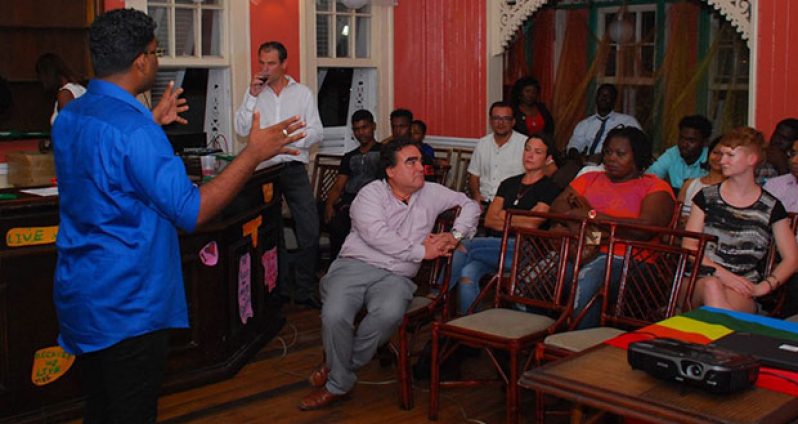By Subraj Singh
The Society Against Sexual Orientation Discrimination (SASOD) and their annual Film Festival have become important societal emblems in the fight for LGBT rights.

(Photo by Ulelli Verbeke, SASOD Guyana)
This year’s festival, subtitled “Painting the Spectrum 12”, runs until June 30th and is hosted at the Dutch Bottle Café. This particular festival has, in a sense, entered the consciousness of open-minded Guyanese and serves this year, as it has been doing for over a decade, to bring together that group of people who by their very presence at the festival serves as a reminder that not everyone in the country is blind to the blatant discrimination meted out to members of the LGBT community, and that there are those among us who can recognize the value of a LGBT-themed film festival.
Firstly, the film festival, at its core, is an artistic presentation (film is art) that is open to the public and is free of charge. Art has always been at the forefront of many great revolutions. An example from local history would be the poetry of Martin Carter. The point of the comparison is to show that art is an important tool in times of social crises and it has the power to combat many ills in our society, including homophobia. Yes, homophobia is a major social ill that has no place in a contemporary society that wants to move forward with the rest of the sane world. Film, as a visual medium, offers the viewer a visceral way of experiencing the LGBT experience. For example, if a gay character in one of the films is physically attacked by homophobic characters then the audience witnesses that event in a way that is most often designed to ensure they feel the impact of what is being done. The actors have to express hate and pain, blood will be seen, the sound effects bring the “thuds” of punching and kicking to life, with the overall effect being one where the attack created is as real as possible so the audience can be lulled into that space where, for just a moment, they become unaware of the fact that what they are seeing is fiction. Such is the power of film. By offering audiences direct and realistic presentations of discrimination, the art of film can make people aware of the pain suffered by the LGBT community in such attacks.

(Photo by Ulelli Verbeke, SASOD Guyana)
In the same manner, moments showing the tenderness and emotions present in LGBT relationships (in the kiss of a pair of lesbians or the way gay men hold hands, for example), the films would be highlighting the core struggle of all LGBT people: simply wanting to be with the person they love, which, when presented onscreen with good actors and directors removes the idea of any possible threat that a skeptical audience might believe they need to expect from LGBT couples. Sometimes, as seen in the film, The Kids are All Right, which was a part of the festival a few years ago, movies can simply show an audience how LGBT people are not so different from heterosexual people at all. We all make mistakes, family is important to all of us, and we all love and want to be loved deeply. In short, by choosing film as a method with which to combat discrimination and sensitize the public about LGBT people, SASOD has really made a clever choice by choosing that artistic mechanism as one of the tools with which to achieve its goals.
Another important role of SASOD’s Film Festival is the way in which it serves as a meeting space for all sorts of people. The attendees of the festival form a spectrum themselves and people from all walks of life converge to see the films every year. With this multitude of personalities comes a range of ideas and opinions that sometimes contradict each other. However, this is a good thing, since one of the aims of the festival is to stimulate conversation and to foster a discussion among the audience members, which in turn serves to dispel myths about the LGBT community and clear up misconceptions people may have, while at the same time affording people who are outside of the community to glean better insight and a deeper understanding of the lives of LGBT people in the hopes of having this understanding lead to a mindset that is supportive of LGBT people. Discussions at the festival allow persons to bring their own experiences to the local conversation. Diplomats may compare the intolerance for LGBT people in Guyana to the way sexual minorities are treated in their own home countries. A transgender person may seek to explain why it is more difficult for him or her to secure employment as compared to other people in the LGBT spectrum who do not face the same difficulties. A young university student might bemoan the fact that Guyana is one of the few countries in the world to still criminalize homosexuality. There might even be one or two persons who seek to explain why they cannot support the LGBT “lifestyle.” Overall, the festival is really a catalyst for important discussions and is one of the few forums that are able to draw such a range of people every year.
For LGBT people themselves, the festival matters because it is one of those rare places in Guyana where members of the community can get together without the fear of being attacked or chastised. There is a special sort of comfort that granted to LGBT people when they attend the SASOD Film Festival because it is a place where people, regardless of gender, are allowed to be themselves. It is a sanctuary that, for one month every year, allows members of the LGBT section of Guyanese society to come together and celebrate, if not anything else, the existence of a vibrant body of LGBT people in Guyana and all their supporters. Furthermore, because of this, the festival can be quite empowering to the LGBT members of it audience, not only because it offers them films where LGBT people are represented and, therefore, ensures that local LGBT people get to see presentations of people like themselves who often overcome barriers such as abuse and discrimination, but also because the environment is one where LGBT persons are allowed to feel accepted and are allowed to be, and to be a part of something important.



.jpg)











